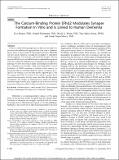Files in this item
The calcium-binding protein EFhd2 modulates synapse formation in vitro and Is linked to human dementia
Item metadata
| dc.contributor.author | Borger, Eva | |
| dc.contributor.author | Herrmann, Abigail | |
| dc.contributor.author | Mann, David | |
| dc.contributor.author | Spires-Jones , Tara | |
| dc.contributor.author | Gunn-Moore, Frank J | |
| dc.date.accessioned | 2014-11-20T10:31:19Z | |
| dc.date.available | 2014-11-20T10:31:19Z | |
| dc.date.issued | 2014-10 | |
| dc.identifier | 153224704 | |
| dc.identifier | 37f0eb29-efa1-4793-8d52-cd24943b6896 | |
| dc.identifier | 84915767481 | |
| dc.identifier | 84915767481 | |
| dc.identifier | 25383639 | |
| dc.identifier | 000345294200008 | |
| dc.identifier.citation | Borger , E , Herrmann , A , Mann , D , Spires-Jones , T & Gunn-Moore , F J 2014 , ' The calcium-binding protein EFhd2 modulates synapse formation in vitro and Is linked to human dementia ' , Journal of Neuropathology & Experimental Neurology , vol. 73 , no. 12 , pp. 1166-1182 . https://doi.org/10.1097/NEN.0000000000000138 | en |
| dc.identifier.other | ORCID: /0000-0003-3422-3387/work/34730426 | |
| dc.identifier.other | ORCID: /0000-0003-4965-2969/work/30767000 | |
| dc.identifier.uri | https://hdl.handle.net/10023/5804 | |
| dc.description | This work was funded by a research grant from Alzheimer’s Research UK (Eva Borger, Tara Spires-Jones, Frank Gunn-Moore) and the 600th University of St. Andrews anniversary BRAINS appeal. | en |
| dc.description.abstract | EFhd2 is a calcium-binding adaptor protein that has been found to be associated with pathologically aggregated tau in the brain in Alzheimer disease and in a mouse model of frontotemporal dementia. EFhd2 has cell type–specific functions, including the modulation of intracellular calcium responses, actin dynamics, and microtubule transport. Here we report that EFhd2 protein and mRNA levels are reduced in human frontal cortex tissue affected by different types of dementia with and without tau pathology. We show that EFhd2 is mainly a neuronal protein in the brain and is abundant in the forebrain. Using short hairpin RNA–mediated knockdown of EFhd2 expression in cultured cortical neurons, we demonstrate that loss of EFhd2 affects the number of synapses developed in vitro whereas it does not alter neurite outgrowth per se. Our data suggest that EFhd2 is involved in the control of synapse development and maintenance through means other than affecting neurite development. The changes in expression levels observed in human dementias might, therefore, play a significant role in disease onset and progression of dementia, which is characterized by the loss of synapses. | |
| dc.format.extent | 17 | |
| dc.format.extent | 24531744 | |
| dc.format.extent | 600721 | |
| dc.language.iso | eng | |
| dc.relation.ispartof | Journal of Neuropathology & Experimental Neurology | en |
| dc.subject | Alzheimer disease | en |
| dc.subject | Cortical neurons | en |
| dc.subject | EFhd2 | en |
| dc.subject | Frontotemporal dementia | en |
| dc.subject | Frontotemporal lobar degeneration | en |
| dc.subject | Swiprosin-1 | en |
| dc.subject | Synapses | en |
| dc.subject | QH301 Biology | en |
| dc.subject | SDG 3 - Good Health and Well-being | en |
| dc.subject.lcc | QH301 | en |
| dc.title | The calcium-binding protein EFhd2 modulates synapse formation in vitro and Is linked to human dementia | en |
| dc.type | Journal article | en |
| dc.contributor.institution | University of St Andrews. School of Biology | en |
| dc.contributor.institution | University of St Andrews. Institute of Behavioural and Neural Sciences | en |
| dc.contributor.institution | University of St Andrews. Biomedical Sciences Research Complex | en |
| dc.identifier.doi | 10.1097/NEN.0000000000000138 | |
| dc.description.status | Peer reviewed | en |
This item appears in the following Collection(s)
Items in the St Andrews Research Repository are protected by copyright, with all rights reserved, unless otherwise indicated.


